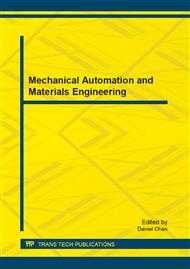p.244
p.248
p.253
p.257
p.262
p.267
p.275
p.280
p.285
A Novel RFID-Based Thermal Convection Accelerometer with Heater and Thermal Piles Deposited by E-Gun Focused on Mixing Powders of Metals
Abstract:
This paper proposes an innovated method to integrate an active RFID tag with a thermal convection accelerometer with heater and thermal piles deposited on a flexible substrate by E-gun, thus it is a wireless sensor for easy usage in many fields. The other advantages of the new device are as: (1) The thermal conductivity (λ148W/(mK)) of the traditional Si is about 25 times of the proposed polyimide substrate (λ6-0.17W/(mK)), thus the power leakage through the substrate is reduced. (2) The heaters and the thermal piles are deposited by E-gun focused on a target of mixing powders of metals on the flexible substrate, so it is different from the traditional ones by using the structures floating over a grooved cavity. Thus the new device is not only easy to make, but more reliable to operate in large acceleration impact condition without damage. (3) The thermal piles are divided into two portions respectively exposed to a cold region and a hot region. The cold junctions of thermal piles are put outside the cap to make it exactly at the room temperature, thus the device is very easy to calibrate and more accurate. (4) The chamber is filled with another kind of gas such as Xe or Ar to avoid the oxidizing effect produced by the commercial ones with carbon dioxide or air, and then the reliability as well as the life cycle of the heater can be increased. (5) By the results of simulation, one can see the traditional rectangular chamber can be replaced by a hemi-cylindrical one to extend both the operation range and sensitivity of the thermal convection accelerometer.
Info:
Periodical:
Pages:
262-266
Citation:
Online since:
August 2013
Authors:
Price:
Сopyright:
© 2013 Trans Tech Publications Ltd. All Rights Reserved
Share:
Citation:


